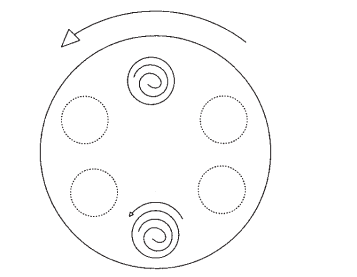
RPN2510EUM Chapter 7 Rev C 06/2007 10
Several advantages are associated with performing hybridizations in bottles,
namely those of safety and economy as outlined in the introduction. However,
the use of bottles for hybridizations and washing procedures requires certain
adaptations to standard protocols.
7.1. Assembly of membranes into bottles
1. Add approximately 20 ml 2 × SSC buffer into the hybridization bottle. The
rotisserie acts as a convenient bottle stand.
2. Pre-wet the membrane in 2 × SSC buffer and loosely roll it up.
3. Insert the rolled up membrane into the bottle and replace the cap. Ensure
that the cap is screwed on securely, (hand tight plus a quarter turn). DO NOT
OVERTIGHTEN, or the thread of the cap can be damaged, leading to leakages.
4. Place the bottle on a flat surface and roll it gently in the opposite direction to
that in which the membrane is coiled. This rolling action causes the membrane
to uncoil, so lining the inner surface of the bottle.
However, studies at GE Healthcare laboratories using a wide range of hybridization
mesh technologies demonstrate a resulting loss of sensitivity due to partial
absorption of the probe into the mesh.
A nylon mesh (RPN2519) is available as an optional extra, as it can facilitate easier
handling of a number of blots and the more fragile nitrocellulose membranes.
These handling advantages should be considered against the potential loss of
sensitivity before use.
When a hybridization mesh is used in conjunction with the membrane, the
following procedure should be adopted:
5. Pre-wet the mesh alongside the membrane in 2 × SSC buffer and place the
prewetted membrane on top of the mesh. The mesh should be slightly larger
than the blot in all dimensions. Roll both up together, with the mesh on the
outside of the membrane, and insert into the bottle as described above (7.1.4.).
7.2. Hybridization
1. Set the required oven temperature as detailed in section 5.1.
2. Discard the 2 × SSC, used in the bottle to unroll the membrane, and replace
with prehybridization buffer. Recommended volumes are provided in most GE
Healthcare protocol booklets. Generally a minimum of 10–15 ml per 20 × 20 cm
blot is advised. Seal the bottle, avoiding overtightening.
3. Place the hybridization bottle(s) into the rotisserie (as detailed in section 5.2.) add
counterbalance bottles if necessary. Place the rotisserie into the oven so that
the bottles are rotating in the same direction as the membrane is rolled, see
Figure 3.
7. Hybridization using the rotisserie
rotation of
membrane
NOTE: If placing several small blots into
one bottle, prewet the membranes as
above, and space them out along the
length of the bottle with forceps.
NOTE: The use of a mesh in bottle
hybridizations to ensure uniform
contact between the membrane
surface and the buffer has been
recommended.
Fig 3. Rotation of rotisserie


















